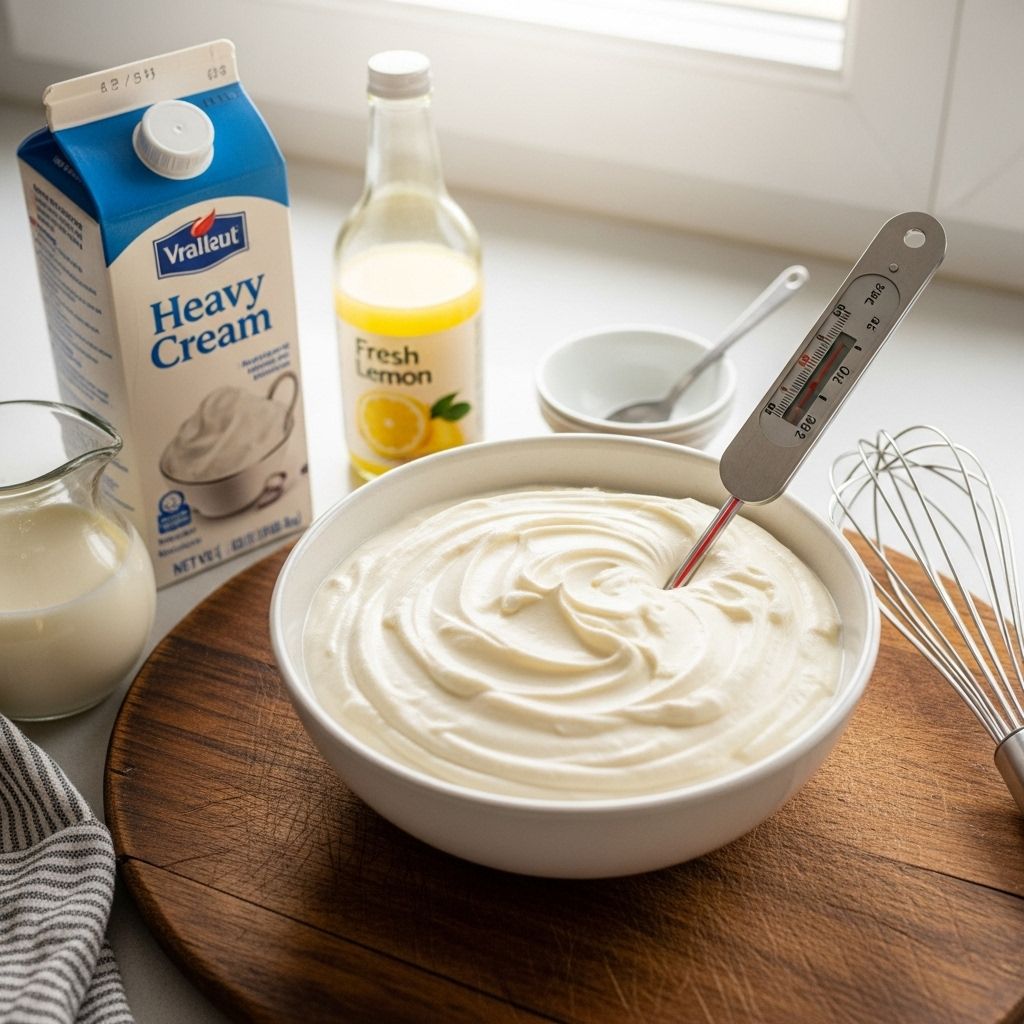How To Make Mascarpone Cheese In 5 Simple Steps
Master this elegant Italian-style cream cheese with just heavy cream and lemon juice

Image: HearthJunction Design Team
Homemade Mascarpone Cheese: Simple Luxury in Two Ingredients
Mascarpone cheese, the silky Italian-style cream cheese known for its rich texture and subtle flavor, may seem like something only professional cheesemakers could produce. However, this luxurious cheese is surprisingly simple to make at home with just two basic ingredients and minimal effort. Whether you’re looking to elevate your homemade tiramisu or seeking a decadent spread for breakfast toast, learning to make mascarpone opens up a world of culinary possibilities.
What is Mascarpone Cheese?
Mascarpone is an Italian cream cheese that originated in the Lombardy region of Italy. Unlike regular cream cheese, mascarpone has a higher fat content, making it exceptionally smooth and rich. Its mild, slightly sweet flavor makes it incredibly versatile, perfect for both sweet and savory applications. While store-bought versions are readily available, homemade mascarpone offers superior freshness and a satisfaction that comes from crafting something special in your own kitchen.
Traditional mascarpone contains between 60-75% butterfat, giving it that characteristic luxurious mouthfeel that’s difficult to replicate with other dairy products. The texture ranges from soft and spreadable to firm and sliceable, depending on the production method. What makes this cheese particularly special is that, unlike aged cheeses that require special equipment and cultures, mascarpone can be made easily at home with impressive results.
The Simplicity of Homemade Cheese
While many artisanal cheeses require specialized equipment, cultures, or aging techniques, mascarpone stands out as an exception. As Chef John notes, “I’ll leave real cheese making to the experts, as their Cheddar, Brie, and blues will almost certainly be better than anything I can make… But there are a few simple, fresh cheeses that anyone can make at home, and mascarpone is one of the best.”
The beauty of homemade mascarpone lies in its simplicity—just two ingredients and a few minutes of active preparation time. The rest is simply waiting as chemistry works its magic. What you get is a freshly made Italian-style cream cheese that rivals or even surpasses commercial versions in flavor and texture.
Ingredients for Homemade Mascarpone
One of the most appealing aspects of making mascarpone at home is the minimal ingredient list. You’ll need just two items:
- Heavy Cream – 2 cups, preferably pasteurized but not ultra-pasteurized
- Lemon Juice – Fresh is best for optimal flavor
When selecting your heavy cream, look for a product with approximately 40% butterfat content. While pasteurized cream works well for this recipe, it’s generally recommended to avoid ultra-pasteurized cream if possible, as it may not set up with the same consistency. The quality of your cream directly impacts the final product, so choose the freshest, highest quality cream you can find.
Equipment You’ll Need
Another advantage of making mascarpone at home is that it requires no specialized equipment. You’ll need:
- Heavy-bottomed saucepan
- Thermometer (optional but helpful)
- Cheesecloth or fine-mesh strainer
- Bowl for draining
- Wooden spoon or heat-resistant spatula
- Storage container
Most home cooks already have these items in their kitchen, making this an accessible project even for beginners. The process is straightforward enough that you don’t need any special cheesemaking tools or molds.
Step-by-Step Mascarpone Method
Making mascarpone at home follows a simple process that relies on acid to thicken cream into a spreadable cheese. Here’s how to do it:
1. Heat the Cream
Pour the heavy cream into a heavy-bottomed saucepan and set over medium heat. Warm the cream gradually until it reaches between 185°F and 190°F (85-88°C). If you don’t have a thermometer, look for the cream to be just barely beginning to simmer with tiny bubbles forming around the edges. Be careful not to let it boil.
2. Add Acidity
Once the cream reaches the proper temperature, remove it from the heat and add the lemon juice. Stir gently but thoroughly to incorporate the acid throughout the cream. You’ll notice the mixture begin to thicken slightly, but the real thickening happens during the cooling and resting period.
3. Allow to Set
Transfer the mixture to a heat-safe container and allow it to cool to room temperature. Once cooled, cover and refrigerate overnight or for at least 8 hours. During this resting period, the acidity works to thicken the cream into the characteristic mascarpone texture.
4. Drain (If Necessary)
After the resting period, your mascarpone may have some excess liquid. If so, line a fine-mesh strainer with cheesecloth and place it over a bowl. Gently transfer the thickened cream to the lined strainer and allow it to drain in the refrigerator for a few hours until it reaches your desired consistency.
5. Store
Transfer the finished mascarpone to an airtight container. Properly stored in the refrigerator, homemade mascarpone will keep for about a week.
Texture Variables and Customization
One of the advantages of making mascarpone at home is the ability to customize its texture according to your preferences. As Chef John explains, “There are lots of methods for making this, but they all involve heating the cream, adding lemon juice, or other form of acid, and then letting the mixture thicken overnight in the fridge. Some versions use lower heat, and shorter cooking times, for a softer mascarpone, but I prefer to push the envelope, since I like a firm, relatively dry cream cheese.”
To achieve a softer, more spreadable mascarpone, you can heat the cream to a slightly lower temperature (around 180°F) and use a shorter cooking time. For a firmer texture better suited to desserts like cheesecake, heat your cream to the higher end of the recommended range and allow it to set thoroughly.
Using Your Homemade Mascarpone
Fresh mascarpone is incredibly versatile and can be used in countless ways. Here are some delicious applications for your homemade cheese:
Sweet Applications
- Classic Tiramisu – The most famous use for mascarpone
- Cheesecake – Creates an exceptionally creamy texture
- Fruit Topping – Mix with a little sugar and vanilla, then spread on toast and top with fresh berries
- Frosting – Whip with powdered sugar for a luxurious cake frosting
- Cannoli Filling – Mix with ricotta for authentic Italian pastries
Savory Applications
- Spread – Season with salt and herbs for bread or crackers
- Pasta Sauce Base – Creates rich, creamy sauces
- Risotto Finisher – Stir in at the end for extra creaminess
- Crostini Topping – Spread on toasted bread and top with roasted vegetables or cured meats
As Chef John suggests, “if you’re going to enjoy it plain, you might want to season it with a pinch of salt. That’s pretty much all you need before spreading it on some bread, where it’s ready to top with sliced tomatoes, or grilled vegetables.”
Mascarpone vs. Other Cream Cheeses
| Cheese Type | Fat Content | Texture | Flavor | Best Uses |
|---|---|---|---|---|
| Mascarpone | 60-75% | Smooth, spreadable | Mild, slightly sweet | Tiramisu, desserts, spreads |
| American Cream Cheese | 33% | Firm, dense | Tangy, more acidic | Cheesecake, bagels |
| Ricotta | 13% | Grainy, fluffy | Mild, slightly sweet | Lasagna, cannoli |
| Crème Fraîche | 30-45% | Soft, pourable | Tangy, nutty | Sauces, garnish |
While regular cream cheese is delicious in its own right, mascarpone offers a richer, creamier alternative with less tanginess. As Chef John notes, “if you like regular cream cheese, you will love this.” The higher fat content and milder flavor make it especially suitable for desserts where you want richness without overwhelming tartness.
Troubleshooting Your Mascarpone
Even with a recipe this simple, occasional issues can arise. Here are solutions to common problems:
- Mascarpone didn’t thicken: Your cream may have been ultra-pasteurized, or the temperature wasn’t high enough. Make sure to heat to at least 185°F and consider using a different brand of cream.
- Too runny: Drain longer through cheesecloth in the refrigerator until desired consistency is reached.
- Too firm: Whisk in a small amount of heavy cream to loosen the texture.
- Grainy texture: The cream may have been heated too quickly or unevenly. Next time, heat more gradually and stir frequently.
Storing Your Homemade Mascarpone
Proper storage is essential for maintaining the quality of your homemade mascarpone. Keep it in an airtight container in the refrigerator, where it will remain fresh for about a week. Unlike aged cheeses, fresh mascarpone is best used relatively quickly after making.
For the best flavor and texture, allow the mascarpone to come to room temperature before using it in recipes, especially desserts. This helps it incorporate more smoothly with other ingredients and enhances its natural flavor profile.
Frequently Asked Questions (FAQs)
Q: Can I substitute other acids for lemon juice?
A: Yes, you can use other food-grade acids like white vinegar, citric acid, or tartaric acid. These may impart slightly different flavors to your finished cheese.
Q: Why is ultra-pasteurized cream not recommended?
A: Ultra-pasteurized cream has been heated to very high temperatures, which can affect its ability to thicken properly when making cheese. It can still work, but may yield inconsistent results.
Q: How can I tell if my mascarpone has gone bad?
A: Signs include a sour smell (different from its normal mild scent), mold, discoloration, or an off taste. When in doubt, discard it.
Q: Can I freeze homemade mascarpone?
A: While possible, freezing is not recommended as it can alter the texture, making it grainy or separated when thawed.
Q: Is there a dairy-free alternative to mascarpone?
A: Yes, you can make dairy-free versions using coconut cream, cashew cream, or commercial plant-based alternatives, though the flavor and texture will differ from traditional mascarpone.
Conclusion: The Joy of Homemade Cheese
Making mascarpone at home is a simple yet rewarding culinary project that yields impressive results with minimal effort. The freshness and quality of homemade mascarpone can elevate your cooking and baking to new heights, whether you’re creating classic Italian desserts or experimenting with new applications.
As Chef John summarizes, “Other than the little bit of acidity from the lemon juice, this is unflavored, so if you’re going to enjoy it plain, you might want to season it with a pinch of salt… For a more desserty application, mix in a bit of sugar, and vanilla, and spread on a piece of toast before topping with fresh fruit. Those are just a few ideas, but no matter how you enjoy yours, I really do hope you give this easy cheese a try soon.”
With just two ingredients and a bit of patience, you can create a cheese that rivals anything you’d find at specialty stores. The satisfaction of creating something so delicious from scratch makes the process as rewarding as the result.
References
Read full bio of Shinta












